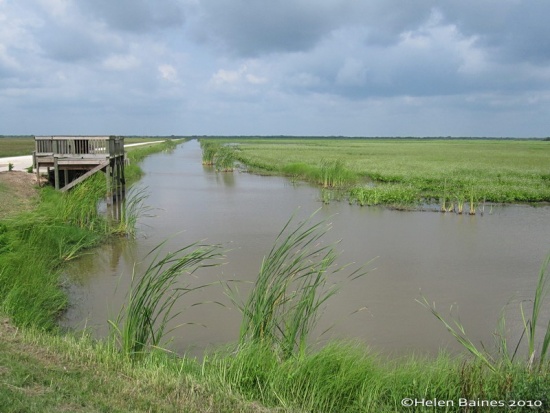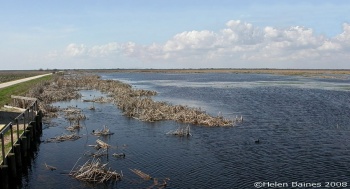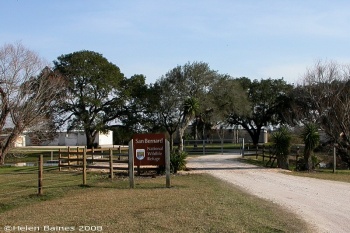(update Spring events) |
(Spring Migration update) |
||
| Line 7: | Line 7: | ||
This NWR is site '''UTC 125''' on the '''Great Texas Coastal Birding Trail'''. | This NWR is site '''UTC 125''' on the '''Great Texas Coastal Birding Trail'''. | ||
| − | '''Annual Migration Celebration''' will be held at San Bernard NWR on Sat/Sun, April | + | '''Annual Migration Celebration''' will be held at San Bernard NWR on Sat/Sun, April 16th-17th, 2016. Events include: bird banding demonstrations, birds of prey shows, guided nature walks, marsh buggy tours, etc ~ [http://www.migrationcelebration.org/ more information]. |
==Birds== | ==Birds== | ||
Revision as of 02:35, 3 April 2016

Moccasin Pond, looking west on the 3 mile tour loop, San Bernard NWR, Upper Texas Coast, June 2010
Overview
San Bernard, along with Big Boggy and Brazoria National Wildlife Refuges, is part of an important series of coastal wetlands, on the Central Flyway migratory route, with over 300 species of birds. It is 43,388 acres in size and located south of Houston, in Brazoria County, near the Freeport/Lake Jackson area of the Upper Texas Coast.
This NWR is site UTC 125 on the Great Texas Coastal Birding Trail.
Annual Migration Celebration will be held at San Bernard NWR on Sat/Sun, April 16th-17th, 2016. Events include: bird banding demonstrations, birds of prey shows, guided nature walks, marsh buggy tours, etc ~ more information.
Birds

Moccasin Pond, looking west from the Observation Platform, San Bernard NWR, Upper Texas Coast, Feb. 2008
Notable Species
The 3 refuges in the Texas Mid-Coast Refuge Complex have been designated an internationally significant shorebird site, by the Western Hemisphere Shorebird Reserve Network. During Spring and Fall migration, dowitchers, Dunlins, Lesser Yellowlegs, Semipalmated Sandpipers and Western Sandpipers can be seen, plus raptors such as Swainson's Hawk. In winter the Refuge is home to thousands of Snow Geese, Greater White-fronted Geese, many species of waterfowl, and raptors, such as Bald Eagle, Peregrine Falcon, Northern Harrier and Osprey.
Check-list
Birds you can see here include:
Black-bellied Whistling-Duck, Fulvous Whistling-Duck,Greater White-fronted Goose, Snow Goose, Ross's Goose, Canada Goose, Wood Duck, Gadwall, American Wigeon, Mallard, Mottled Duck, Blue-winged Teal, Cinnamon Teal, Northern Shoveler, Northern Pintail, Green-winged Teal, Canvasback, Redhead, Ring-necked Duck, Lesser Scaup, Bufflehead, Common Goldeneye, Hooded Merganser, Red-breasted Merganser, Ruddy Duck, Northern Bobwhite, Common Loon, Pied-billed Grebe, Eared Grebe, American White Pelican, Brown Pelican, Neotropic Cormorant, Double-crested Cormorant, Anhinga, Magnificent Frigatebird, American Bittern, Least Bittern, Great Blue Heron, Great Egret, Snowy Egret, Little Blue Heron, Tricolored Heron, Reddish Egret, Cattle Egret, Green Heron, Black-crowned Night-Heron, Yellow-crowned Night-Heron, White Ibis, White-faced Ibis, Roseate Spoonbill, Wood Stork, Black Vulture, Turkey Vulture, Osprey, Swallow-tailed Kite, White-tailed Kite, Mississippi Kite, Bald Eagle, Northern Harrier, Sharp-shinned Hawk, Cooper's Hawk, Red-shouldered Hawk, Broad-winged Hawk, Swainson's Hawk, White-tailed Hawk, Red-tailed Hawk, Crested Caracara, American Kestrel, Merlin, Peregrine Falcon, Yellow Rail, Black Rail, Clapper Rail, King Rail, Virginia Rail, Sora, Purple Gallinule, Common Gallinule, American Coot, Sandhill Crane, Black-bellied Plover, American Golden Plover, Snowy Plover, Wilson's Plover, Semipalmated Plover, Piping Plover, Killdeer, American Oystercatcher, Black-necked Stilt, American Avocet, Spotted Sandpiper, Solitary Sandpiper, Greater Yellowlegs, Willet, Lesser Yellowlegs, Upland Sandpiper, Whimbrel, Long-billed Curlew, Hudsonian Godwit, Marbled Godwit, Ruddy Turnstone, Red Knot, Sanderling, Semipalmated Sandpiper, Western Sandpiper, Least Sandpiper, White-rumped Sandpiper, Baird's Sandpiper, Pectoral Sandpiper, Dunlin, Stilt Sandpiper, Buff-breasted Sandpiper, Short-billed Dowitcher, Long-billed Dowitcher, American Woodcock, Wilson's Snipe, Wilson's Phalarope, Laughing Gull, Franklin's Gull, Bonaparte's Gull, Ring-billed Gull, American Herring Gull, Sooty Tern, Least Tern, Gull-billed Tern, Caspian Tern, Black Tern, Common Tern, Forster's Tern, Royal Tern, Sandwich Tern, Black Skimmer, Rock Dove, White-winged Dove, Mourning Dove, Common Ground Dove, Yellow-billed Cuckoo, Barn Owl, Eastern Screech Owl, Great Horned Owl, Barred Owl, Common Nighthawk, Chimney Swift, Ruby-throated Hummingbird, Belted Kingfisher, Red-bellied Woodpecker, Yellow-bellied Sapsucker, Northern Flicker, Pileated Woodpecker, Olive-sided Flycatcher, Eastern Wood Pewee, Yellow-bellied Flycatcher, Acadian Flycatcher, Alder Flycatcher, Willow Flycatcher, Least Flycatcher, Eastern Phoebe, Vermilion Flycatcher, Ash-throated Flycatcher, Great Crested Flycatcher, Eastern Kingbird, Scissor-tailed Flycatcher, Loggerhead Shrike, White-eyed Vireo, Yellow-throated Vireo, Blue-headed Vireo, Warbling Vireo, Philadelphia Vireo, Red-eyed Vireo, Blue Jay, American Crow, Horned Lark, Northern Rough-winged Swallow, Purple Martin, Tree Swallow, Bank Swallow, Barn Swallow, Cliff Swallow, Cave Swallow, Carolina Chickadee, Tufted Titmouse, Carolina Wren, House Wren, Sedge Wren, Marsh Wren, Golden-crowned Kinglet, Ruby-crowned Kinglet, Blue-gray Gnatcatcher, Eastern Bluebird, Hermit Thrush, American Robin, Gray Catbird, Northern Mockingbird, Brown Thrasher, European Starling, American Pipit, Sprague's Pipit, Cedar Waxwing, Blue-winged Warbler, Golden-winged Warbler, Tennessee Warbler, Orange-crowned Warbler, Nashville Warbler, Yellow Warbler, Chestnut-sided Warbler, Magnolia Warbler, Yellow-rumped Warbler, Black-throated Green Warbler, Blackburnian Warbler, Yellow-throated Warbler, Palm Warbler, Bay-breasted Warbler, Blackpoll Warbler, Black-and-white Warbler, American Redstart, Worm-eating Warbler, Ovenbird, Northern Waterthrush, Louisiana Waterthrush, Kentucky Warbler, Common Yellowthroat, Wilson's Warbler, Canada Warbler, Summer Tanager, Scarlet Tanager, Eastern Towhee, Field Sparrow, Vesper Sparrow, Lark Sparrow, Savannah Sparrow, Grasshopper Sparrow, Le Conte's Sparrow, Nelson's Sparrow, Seaside Sparrow, Song Sparrow, Lincoln's Sparrow, Swamp Sparrow, White-throated Sparrow, White-crowned Sparrow, Northern Cardinal, Blue Grosbeak, Indigo Bunting, Painted Bunting, Dickcissel, Red-winged Blackbird, Eastern Meadowlark, Brewer's Blackbird, Common Grackle, Boat-tailed Grackle, Great-tailed Grackle, Brown-headed Cowbird, Orchard Oriole, Baltimore Oriole, American Goldfinch, House Sparrow
Other Wildlife
River otter, raccoon, possum, bobcat, American Alligator, snakes and other reptiles, frogs.
Site Information
History and Use
Before the first European settlers arrived, the Karankawa Indians lived here, surviving on the land's plentiful wildlife and fish. By 1825, sugar cane and cotton was grown by the Spanish, then the Mexicans. In more recent times, the area was used for cattle ranching until it became a wildlife refuge.
Areas of Interest
- 3-mile Moccasin Pond auto tour
- Bobcat Woods, Scissor-tail and Cow Trap Marsh hiking trails
- Cocklebur Slough boardwalk
- Wolfweed Wetland Complex
Access and Facilities
- Open every day from dawn to dusk
- No entrance fees
- Bathrooms in the visitor center, which is located on CR 306 before the main entrance into the Refuge. Maps and brochures are available here.
- Bathroom also at the entrance to the Bobcat Woods trail in the Refuge
- Map of the Refuge System on the Upper Texas Coast
Directions:
From Lake Jackson: Take FM 2004 SW for 7 miles. Go across Hwy 36 and continue SW on FM 2611 for 4 miles, then turn left onto FM 2918. Drive one mile south on FM 2918 and turn right onto CR 306. Drive about 3 miles to the Refuge entrance on the left.
Contact Details
1212 North Velasco, Suite 200
Angelton, TX 77515
Phone: 979-849-7771
External Links
- USFWS Official website
- Friends of San Bernard NWR website
- Annual Spring Migration events in April
- Great Texas Coastal Birding Trail - San Bernard Loop
Content and images originally posted by HelenB






